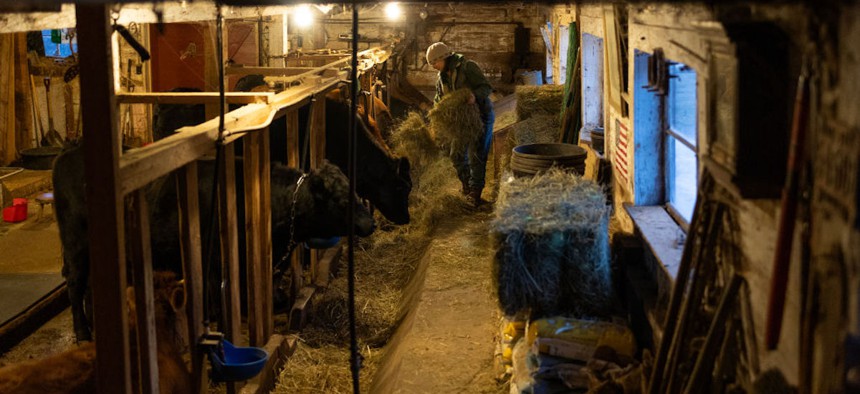Rural employment edges back to pre-pandemic numbers

Dairy farmers at a family run farm bring the cows in for their daily milking and feeding in the rural White Mountain village of Chatham, New Hampshire, on Dec. 16, 2023. Andrew Lichtenstein/Corbis via Getty Images
The number of jobs grew in November 2023, according to a recent report from the Bureau of Labor Statistics.
This story is republished from The Daily Yonder. Read the original article.
Three-and-a-half years after the Covid-19 pandemic created massive layoffs, rural workers are right back where they started, according to a Daily Yonder analysis of data from the Bureau of Labor Statistics (BLS).
The latest monthly county-level employment report from BLS shows that rural counties have a few more jobs now than they did before the start of the pandemic. Rural counties had 20.3 million jobs in November 2023, the most recent month available. That’s about 2,000 more jobs than those counties had in the same month before the start of the pandemic (November 2019).
The increase amounts to only 0.01%. It’s a tiny gain, but it represents only the third time since the pandemic that rural employment hit pre-pandemic levels. Rural employment also nudged into positive territory compared to pre-pandemic job reports in March and April of 2023.
Meanwhile, metropolitan America got back to pre-pandemic employment two years ago and has been in positive territory ever since.
The graph above compares each month’s total employment to the same month in 2019, the last full year before the pandemic. The sharp dip in March and April 2020 shows the massive job losses associated with the economic shutdown. For the next two years, metropolitan and rural counties recovered jobs at roughly the same pace. Metropolitan employment moved into the black in late 2022 while rural employment gains have remained stagnant or below pre-pandemic numbers for the last year.
Sanpete, Utah and Jackson, Georgia, See Big Gains in Employment
Although employment in rural America improved overall, some rural areas lost jobs while others blew the rest of the country out of the water in terms of job growth.
Counties where local, state, and federal government employment is a big part of the economy tended to do better than other rural counties.
An example is Sanpete County, Utah, a mountainous community in the middle of the state with a population of 28,000. State parks and national forests are a big part of the local economy.
Sanpete added about 1,500 new jobs in November of 2023, a 13% increase since November of 2019.
Although rural counties dependent on manufacturing didn’t fare quite as well as a group, there were big exceptions. Jackson County, Georgia, for example, is another rural county with some of the best post-pandemic job growth. In 2019, GE Appliance opened a new distribution center, creating 300 new jobs, according to the Jackson Alliance for Economic Development.
Between November of 2019 and November of 2023, employment in Jackson County grew by 22%, adding about 8,000 new jobs to the local economy.
Rural Counties Dependent on Mining Fall Furthest Behind
Counties dependent on mining and natural resource extraction had the worst employment performance out of all rural counties last November. Between November of 2019 and November of 2023, rural mining counties lost 22,000 jobs, a 1.6% drop since the pandemic.
Oil and natural gas extraction is the dominant industry in Chase County, Kansas, a rural community of about 2,500 people in the eastern part of the state. Employment dropped by 21% in Chase County, from 1,529 in November of 2019 to 1,208 jobs in November of 2023.
In rural Williams County, North Dakota, employment dropped by 6% between November 2019 and November of 2023. About 38,000 people live in Williams County, where oil extraction is the major driver of economic activity.
Out of the 181 rural mining counties, only 40% fully recovered their pre-pandemic employment.
Employment in rural counties dependent on farming and related industries dropped by 0.44%, losing about 6,000 jobs between November of 2019 and November of 2023.
Rural manufacturing counties lost 43,000 jobs in November of 2023, a 0.92% drop compared to November of 2019.
In rural places where no single industry dominates the local economy, employment decreased by 0.05%, losing about 4,000 jobs between November of 2019 and November of 2023.
In rural places where the state or local government drives the economy, employment grew by 0.73%. Between November of 2019 and November of 2023, government-driven rural economies gained over 20,000 more jobs.
Recreation-dependent counties, where local businesses rely on natural amenities or tourism, saw the most growth in terms of percent change, as I previously reported. Between November of 2019 and November of 2023, rural recreation counties grew by 1.93%, adding 56,000 jobs to the rural economy. Two thirds of rural recreation counties fully recovered their pre-pandemic employment, compared to only 46% of all 1,975 rural counties.
The Economic Research Service (ERS), part of the USDA devoted to analyzing economic trends, creates these economic types by assigning all U.S. counties into one of six mutually - exclusive categories that best describes the county’s economic dependence. A county can fall into one of the following categories - farming, government, recreation, mining, manufacturing, or “nonspecialized.”
We rely on the Office of Management and Budget (OMB) guidelines to categorize counties as either metropolitan or nonmetropolitan, using the nonmetropolitan category as a proxy for rural.
The analysis is based on monthly county-level job numbers from the BLS. The study compares monthly job figures to the same month in previous years, which factors out seasonal changes that can affect employment from one month to the next.![]()





